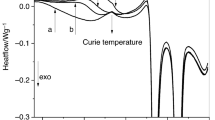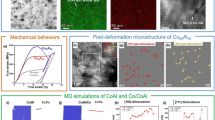Abstract
High temperatures generally affect materials in some form. In this regard, the capability to perform nanoscale measurements at elevated temperatures opens up new possibilities for investigating the temperature dependence of materials’ mechanical properties. Particularly, the responses of aluminum’s different mechanical properties to indentation at various temperatures have been studied experimentally. In this paper, aluminum response to different room temperatures was examined. The behaviors of a single crystal aluminum during loading and unloading were observed. Nanoindentation experiments on a single crystal aluminum (100) sample at temperatures of 265 K and 388 K were performed with different loading conditions. At the start of the first burst of the dislocation glide, which was indicated by a sudden increase in displacement with no increase in loading, evidence of plastic properties and softening effects on aluminum was identified. The ductile to brittle transition was observed at temperatures below 273 K. Generally, there was a significant increase in the penetration depth and a decrease in hardness, elastic modulus, and elastic recovery as the testing temperature increased.
Similar content being viewed by others
References
A. Gouldstone, H. J. Koh, K. Y. Zeng, A. E. Giannakopoulos and S. Suresh, Discrete and continuous deformation during nanoindentation of thin films, Acta Mater. 48 (2000) 2277–2295.
Roger Smith, D. Christopher and S. D. Kenny, Defect generation and pileup of atoms during nanoindentation of Fe single crystals, Phys. Rev. B, 67 (2003) 245405.
D. F. Bahr, D. E. Wilson and D. A. Crowson, Energy considerations regarding yield Points during indentation, J. Mater. Res. 14(6) (1999) 2269.
J. A. Zimmerman, C. L. Kelchner, P. A. Klein, J. C. Hamilton and S. M. Foiles, Surface Step effects on nanoindentation, Phys. Rev. Lett. 87(16) (2001) 165507-1.
R. Komanduri, N. Chandrasekar and L. M. Raff, MD Simulation of indentation and scratching of single crystal aluminum, Wear, 240 (2000) 113–143.
J. D. Kiely, J. F. Jarausch, J. E. Houston and P. E. Russell, Initial stages of yield in nanoindentation, J. Mater. Res. 14(6) (1999) 2219.
J. F. Smith and S. Zhang, High temperature nanoscale mechanical property measurements, Surface Engineering, 16(2) (2000) 143–146.
M. V. Swain and J. Mencik, Mechanical property characterization of thin films using spherical tipped indenters, Thin Solid Films, 253(1–2) (1994) 204–211.
Yu. I. Golovin and S. N. Dub, Stepwise transition from elastic to elastoplastic deformation at the initial stage of nanoindentation, Doklady Physics, 48 (2003) 612–614.
I. Yonenaga, T. Hoshi and A. Usui, High Temperature hardness of Bulk Single Crystal GaN in comparison with other wide-gap materials J. Phys.: Condens.Matter, 12 (2000) 10319–10323.
D. J. Branagan, Y. L. Tang, A. V. Sergueeva and A. K. Mukherjee, Low-temperature superplasticity in a nanocomposite iron alloy derived from a metallic glass, Nanotechnology, 14 (2003) 1216–1222.
Xiao Dong Zhang, Temperature dependence of the structure and mechanical properties of TI-SI-N coatings, ME Graduate student Conference, 2003.
High temperature Nanotesting, Micro materials measuring nanotechnology, www.http://freespace.virgin.net/micro.materials/HITEMP.HTMUT.HTM.
S. Suresh, T. G. Nieh and B. W. Choi, Scripta Materiala, 41(9) (1999) 1999. 95–957.
J. Fraxedas, S. Garcia Manyes, P. Gorostiza and F. Sanz, Nanoindentation: Toward the Sensing of atomic interactions, PNAS, 99 (2002) 5228.
Author information
Authors and Affiliations
Corresponding author
Additional information
This paper was recommended for publication in revised form by Associate Editor Maenghyo Cho
Murugavel Rathinam received his Bachelor of of Engineering degree (B.E) in Mechanical Engineering from University of Madras, India in 1993. He then received his Master’s of Engineering degree (M.E) in Engineering Design from the Government College of Technology in 1997 and his Ph.D. from The Hong Kong Polytechnic University, Hong Kong, in 2004. He served as a Senior Engineer (R&D) in TATA Engineering and Locomotive Company. He is a recipient of the International Fellowship Award from the Hong Kong government. He was also awarded as excellent teacher. Dr. Rathinam is currently the Principal and a professor of Paavai Institutions, India. He has over 16 years of experience in the fields of teaching, research, and the industry. He has enormous international exposure in foreign universities in many countries, and he likewise serves as an editor and reviewer of international journals and books. Dr. Rathinam’s interests include nanotechnology, design, mechanics, materials, solid state electronics, innovative projects, and methodologies.
Rights and permissions
About this article
Cite this article
Rathinam, M., Thillaigovindan, R. & Paramasivam, P. Nanoindentation of aluminum (100) at various temperatures. J Mech Sci Technol 23, 2652–2657 (2009). https://doi.org/10.1007/s12206-009-0718-4
Received:
Revised:
Accepted:
Published:
Issue Date:
DOI: https://doi.org/10.1007/s12206-009-0718-4




